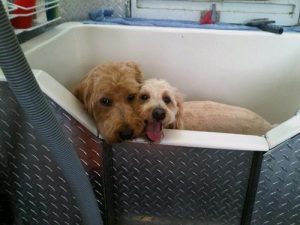Do Your Ears Hang Low? Taking Care of Floppy-Eared Pets
 As any animal lover knows, there are dozens if not hundreds of shapes for mammal ears. From round mousey flares to attentive kitty triangles to long floppy bunny ears, and dog breeds run the gambit with an incredibly wide variety of ear types and sub-type shapes. Because of this incredible difference of ear from pet to pet, naturally not all ear-care is the same. Floppy-eared pets like rabbits, beagles, pigs, and even goats or donkeys (rare but not unheard of) need special care for their ears, which can catch and hold all sorts of things in the folded area protected by the floppy part of the ear. Make sure you’re tending your pet’s ears with the right amount of care, thoroughness, and frequency to ensure they are happy and healthy every day you spend together.
As any animal lover knows, there are dozens if not hundreds of shapes for mammal ears. From round mousey flares to attentive kitty triangles to long floppy bunny ears, and dog breeds run the gambit with an incredibly wide variety of ear types and sub-type shapes. Because of this incredible difference of ear from pet to pet, naturally not all ear-care is the same. Floppy-eared pets like rabbits, beagles, pigs, and even goats or donkeys (rare but not unheard of) need special care for their ears, which can catch and hold all sorts of things in the folded area protected by the floppy part of the ear. Make sure you’re tending your pet’s ears with the right amount of care, thoroughness, and frequency to ensure they are happy and healthy every day you spend together.
Soft, Furry, and Sensitive
Most ears are pretty sensitive. While ear-injuries on people are rare, if you’ve ever experienced a scrape or sharp impact to the ear, it can hurt pretty badly! Floppy ears are even more sensitive, and there’s a lot more of them. For pets with especially long ears, it can be very uncomfortable when they are damaged, clogged, or worse, infected. To know how your pet’s ears are doing, check them closely at least once a week for bald spots, scabs, and internal cleanliness. Remember to be gentle and patient, pets are often shy about letting people ‘mess with’ their soft, sensitive ears.
Identify and Prevent Infections
Because floppy ears form a protected inner area, they tend to catch and hold material like dirt, ear wax, and random particles from playing outside. The worst things that can get into your pet’s ear are bacteria and yeast, both of which can cause an unpleasant infection. Infections can cause redness, swelling, and an unusual odor from the ears, and your pet will experience pain and itching. If you suspect your pet has an ear infection, take them to the vet first. You will want their medical opinion on how you should treat it before you try to clean the infected ear at home. If the ear really is infected, the vet will prescribe medication and probably suggest that you clean the ear gently each time before applying it.
Cleaning Floppy Ears
Pet ears are a lot like people ears, only bigger, softer, and more exposed. It is all too easy to cause damage with careless pressure or delving too deeply into the ear structure. Here are a few suggested supplies to have nearby before you get started:
- several clean cloths, gauze, or cotton balls
- clean warm water
- bottle of safe, pet approved ear-cleaning solution
- bowl of treats to reward your pet for patience and good behavior
Do Not Use
- Ear Swabs – this can hurt your pet and push debris deeper into the ear
- Rubbing Alcohol – this is a drying irritant and will not help as much as you might think
Soothe your pet and hold them still as you use a damp cloth or cotton ball to wipe down the wide, furry parts of the ear and repeat as necessary until the cotton ball comes away clean. Remember to focus on the inner fold where dirt can gather. For normal maintenance, use another clean damp cotton ball to rub gentle circles around the inner part of the ear and repeat until clean. Surprising result at this stage can be a good reason to schedule a vet checkup, as it can be an early indication of an infection. If the ear is already infected, or you are facing an excessive amount of ear wax, it can be useful to fill the ear with a cleaning solution and then rub the canal with a cotton ball to swish it around and pick up the debris it looses.
Your floppy-eared animals do everything they can to be loving pets. They nuzzle your hand when they want to play, they cheer you up when you’re down, and they let you play with their ears. Reward them by taking especially good care of their long, silky ears to help them prevent unnecessary ear infections. For more ways to love your pet through good grooming practices, contact us and talk to a professional San Diego groomer today!
